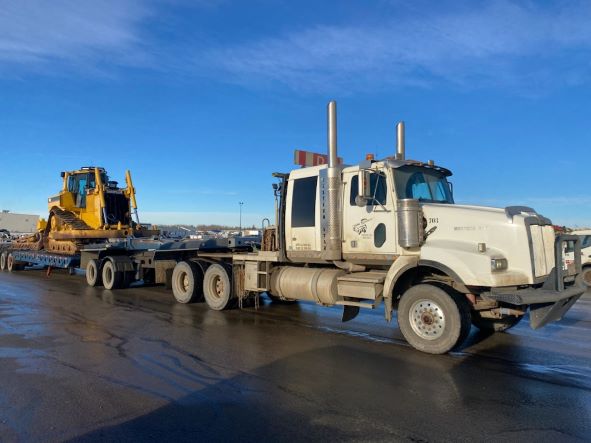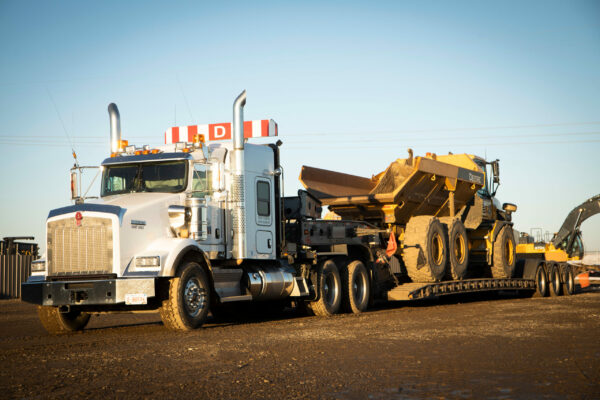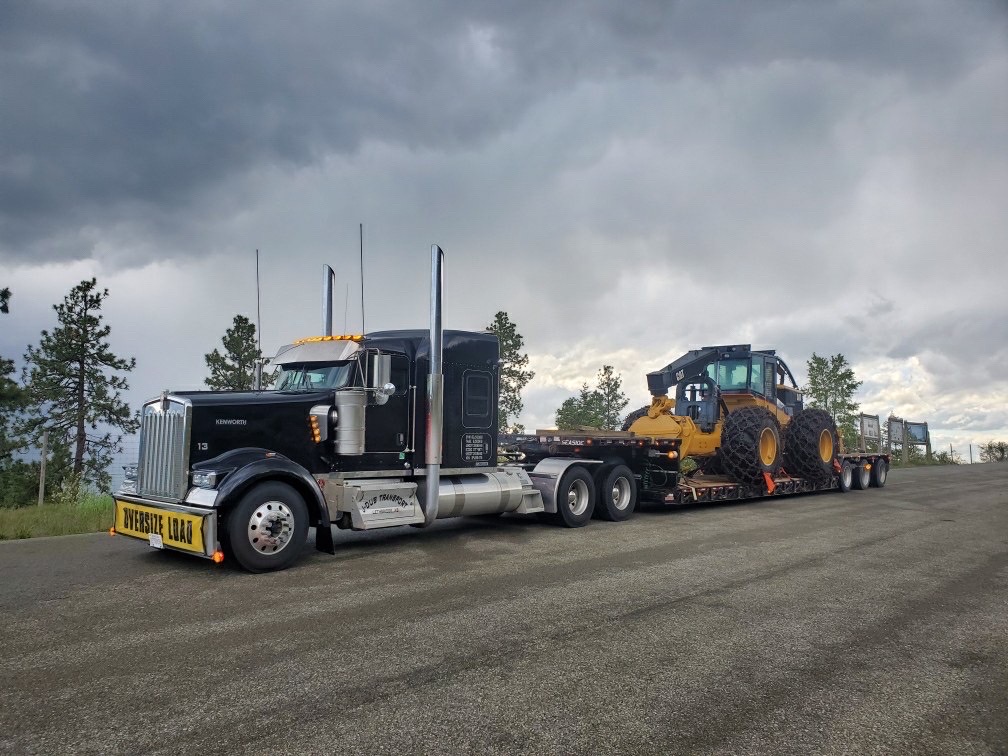Unless you’ve had experience as a trucker, there are many details about trucking that you might not think about. For starters, there is the amount of skill required to drive a semi-truck and pull a trailer with a heavy load on it. Then there is the knowledge of the rules of the road in all regions they need to travel through. Long-haul transport involves transporting shipments over significant distances, even borders, and drivers must be prepared for various situations.
For customers and anyone new to the world of heavy hauling, here are some key parts of heavy hauling you might not have thought about before
What Is Considered a Long Haul?
The general definition of a long haul is any trip extending over 402 km (250 miles) because it means the driver must stop and spend the night somewhere at least once. Short hauls are trips that can be completed in one day and not exceed the maximum hours a driver can be behind the wheel without a break.
Due to the fact that long hauls take two or more days to complete, there is a lot more territory that is covered during a long haul. More ground covered requires more details to coordinate and map out. From the route to drive to the places to stop and eat to the permits required to drive, long hauls take much coordination that many customers don’t know about.
1. Route Planning & Navigation
Any heavy haul requires careful route planning in advance of the pick-up day. This is especially true for long hauls. While a long haul in Canada or the United States could potentially stay within the same province or state, in most cases, there are borders to be crossed, either domestic or international. Knowing where the border crossings happen and how to prepare for the journey helps the driver have an uneventful trip.
For example, if you were to drive in your car from Eastern Canada to Western Canada, you might be tempted to drive south through the northern States and save some time you’d spend driving around the Great Lakes in Canada. As a heavy haul driver, it’s not so easy to cross the border with a load to save time. Crossing the international border between Canada and the United States requires specific paperwork and inspections. It would neither be practical nor advisable to attempt two crossings on a long haul to try and save time. Unless the final destination is in the United States, the trip should be entirely within Canada and vice versa.
Route Considerations
Long hauls require more planning because the trip requires multiple days. Your driver will need to consider road conditions, traffic congestion, and toll routes on every leg of the journey. They’ll also need to consider when and where they will stop to eat, rest, and sleep. There are strict rules in place for how many hours a driver can spend behind the wheel before they are required by law to take a break. And with a big truck and large load, trucks cannot just stop anywhere. They need to find designated rest stops and fuel stations for trucks. Most drivers use GPS devices and navigation apps that cater to commercial trucking and heavy haul transport, which makes route planning easier.
Planning Alternate Routes
An experienced driver will map out more than one route for their journey. This provides the driver with a backup plan in the event that the primary route has an unexpected obstacle, such as a road accident, construction, or an environmental hazard, such as flooding. Drivers can’t automatically take a detour route unless they know it is suitable for the load they’re carrying in terms of size and weight. In some cases, when regular traffic is redirected to one route, truck drivers will need to take a different detour.
2. Regulations & Permits
When travelling long distances takes drivers into different regions, it can bring other changes that drivers need to consider and be prepared for beyond just a change of scenery. Most provinces and territories have similar restrictions when it comes to the limits of size and weight for heavy loads. However, there are some variations due to hazards associated with terrain, weather, and infrastructure available. Standardization is always a goal, but there will always be unique conditions, and drivers must know when and where to travel.
Drivers also need to know when a permit is required for the load they are hauling. That’s the reason why we always ask for the dimensions and weight of your shipment first when you get a free, instant quote. Drivers need to know if they are equipped to handle your load request, plan their potential routes if they accept your job, and prepare to pull the appropriate permits in every region they cross.
Regional Regulations
In addition to requesting the proper permits in each region they travel through, heavy haul drivers must also research limitations on timing. Urban areas typically have restrictions on when an oversized load can be on the busy routes. These rules restrict oversize loads from travelling during peak rush hour times, long weekends, public holidays, and nighttime. Rules like these are in place to avoid extra congestion and to protect public safety.
Your driver will consider all these details when planning their route. Even though you might have a certain date in mind for when you want your equipment to reach the destination, it might not be possible if a holiday or weekend falls during the trip. With heavy hauling, it’s always best to keep flexibility in your timelines.
3. Vehicle Maintenance
Think for a moment about your own vehicle and how many kilometres or miles you can drive before you need to have your oil changed and general maintenance to keep your truck or car running smoothly. Now, think about how many thousands of kilometres or miles your driver puts on their truck in any given period, especially long-haul drivers.
Long-haul truckers need to keep their trucks well-maintained to support their livelihoods. Every trip involves a pre-trip and post-trip inspection to identify any issues and have them looked at by a mechanic. They want to keep their truck performing well to keep them and your load safe on the road. This involves inspecting the trailer, tires, brakes, lights, and other essential components. When everything is in working condition, the trip is safer.
4. Driver Well-Being
One important factor that many customers and non-truck drivers fail to think about is driver well-being. On the surface, driving a vehicle all day may sound fairly easy, when in reality, it is a physically and mentally demanding profession. Truck drivers need to be in control of their vehicles and hauls at all times. They must constantly be alert to the traffic around them and be ready to take swift action to keep themselves, their loads, and the surrounding traffic safe.
Beyond safety on the road, sitting behind the wheel for ten hours a day can be taxing physically and mentally. Trying to stay active and eat well while being a long-haul truck driver is not easy. Experienced professionals know how to find balance while on the road and how to prioritize following the laws of each country on how many hours they can drive before needing to rest. No matter how urgent you want your equipment delivered, your driver cannot and will not exceed the limits of their profession, which are in place to prevent fatigue-related accidents.
5. Communication
Times have changed since truck drivers relied on the CB radio to stay in touch with fellow drivers, their dispatchers, and even their families while on the road. While some truckers still get a kick out of the CB radio system, most truckers today maintain open lines of communication through their cell phones.
Staying connected has several benefits for long-haul truckers:
- Staying on top of weather alerts while on the road keeps drivers from being surprised by bad weather. They also have a chance to pull off the road if the risk is too high to continue with your valuable equipment.
- Hands-free systems allow drivers to call their dispatch, families, or customers while en route to give updates on timelines.
- Having a way to stay in contact with you, the customer, lets the driver keep you updated on progress and ask questions if needed along the way, especially if a border crossing is involved.
6. Weather and Road Conditions
The further drivers travel, the more chances there are to meet poor weather and road conditions. While you can check the forecast days in advance, there are often times the predictions change the day your driver pulls away with your machine on the back. Experienced truckers know that the weather can change and potentially interrupt the plans of the shipment, causing unexpected delays.
How to Be Prepared for Bad Weather
If your load needs to travel through mountains, your driver will need to prepare for all weather possibilities. Mountain passes are known to dump snow even in the middle of July. Pulling a heavy haul through unexpected snow can be a safety risk unless your driver has packed chains or is wise enough to delay driving to wait for sand trucks. A driver that prioritizes safety will not rush your delivery if it puts your load or their health at risk. As a customer with a long haul, it’s up to you to know these factors and be prepared for them.
7. Cargo Securement
Keeping your cargo or heavy machine secure during the entire trip is a priority in long hauls, just as it is in short haul. The main difference is that with a long haul, your driver will need to inspect the load on a continuous basis. Every time the truck stops, an inspection needs to take place to ensure nothing has shifted during transit.
When a heavy piece of machinery is first loaded, it’s important to position it correctly on the trailer before securing the tiedown points with proper chains. An experienced heavy haul driver will know how to do this and won’t leave your driveway until they’ve checked all the essential points. Taking the time to properly load and follow securement procedures makes it easier to maintain stability while in motion.
8. Electronic Logging Devices (ELDs)
Gone are the days of pencil and notebook logging procedures. Most professional drivers today choose to use an electronic logging device, or ELD, to track their hours of service. This makes it easier to report their work to their employers and customers. Electronic tracking also simplifies having to calculate when to take a break and when to rest for the day with automatic alerts.
Other Technology
The trucking industry also has access to new technologies that make life on the road more comfortable, such as GPS navigation systems, BlueTooth technology, and satellite radio. Drivers have a variety of entertainment options at their fingertips, from radio stations to podcasts to audiobooks and the ability to call friends and family no matter where they stop.
9. Emergency Preparedness
Even with the latest technology, being on the road for long stretches at a time alone means that heavy haul drivers need to be prepared for emergencies. Drivers will carry essential tools, equipment, and supplies so they are ready for unexpected situations. These items might include a first aid kit, tools for basic repairs, spare tires, a fire extinguisher, and emergency contact numbers.
10. Professionalism
Experienced long-haul drivers, especially independent owner-operators, take pride in their industry and their work. They prioritize safety, value your business, maintain professionalism, and follow the rules of the road. Having a positive attitude and excellent communication skills can go a long way to maintaining good relationships with clients and colleagues.
Trucking is built on relationships. Disappointing or disrespecting clients only hurts business, and experienced drivers know this. In the Trusted Dispatch network of professional drivers
Long Haul Shipping in North America
When you’re ready to ship your equipment, whether it’s a short-haul or long-haul, Trusted Dispatch is ready to help. Get started today with a free, instant quote and be paired with an experienced heavy haul driver once you post your load.





